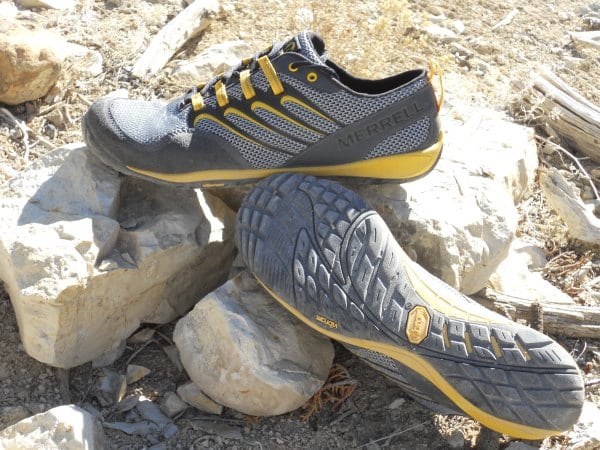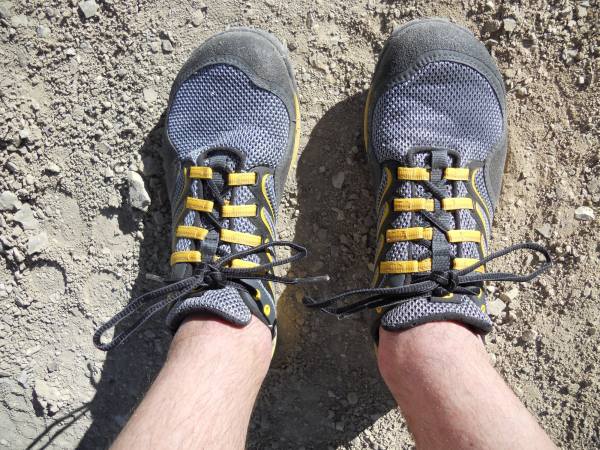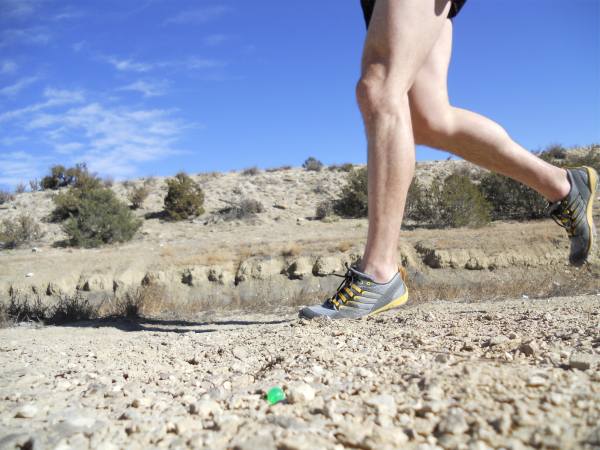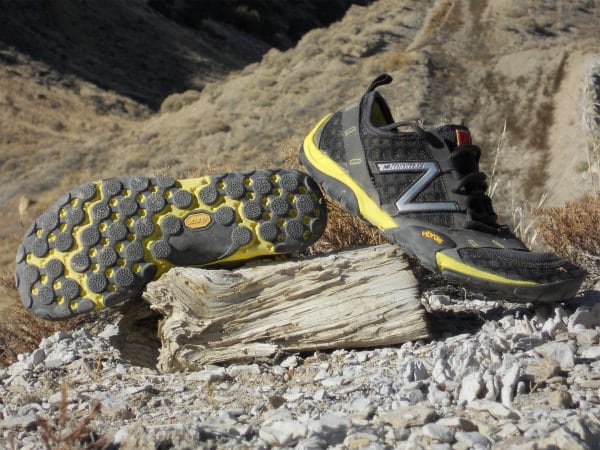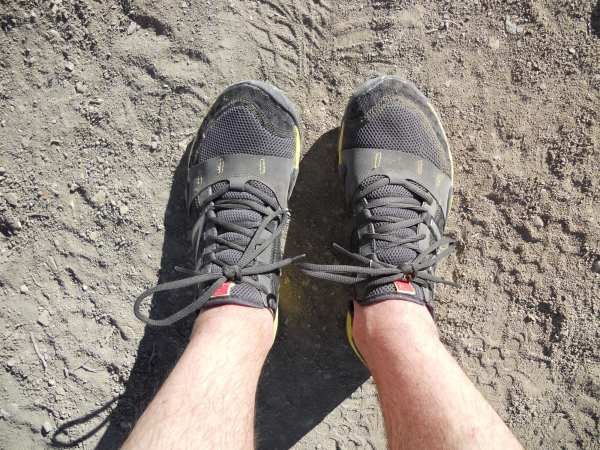Our Favorite Trail Running Shoes
Check out our Best Trail Running Shoes article to learn about our current favorite trail running shoes!
Merrell Trail Glove vs. New Balance Minimus Trail Review
Two minimalist trail running shoes simulating a barefoot running style are being released this winter to major hoopla (the Merrell Trail Glove in February and the New Balance Minimus Trail in March) and I was privileged enough to receive a pair of both. Rather than review these shoes separately, I thought it would benefit discriminating readers and potential purchasers to compare and contrast the shoes as well as their relative performance on the trail.
I should note that both shoes were tested on very soft trails that provided me with enough protection to test and enjoy these shoes to the fullest. Also, both shoes are designed to be worn sockless and were tested in that manner. I would recommend a deliberate and delicate transition to training in either of these shoes, and both manufacturers’ websites include warnings and training tips to incorporate barefoot style running into your regime. Merrell feels strongly enough about needing to educate runners about transitioning to barefoot running that it ask all media to hold off on publishing any reviews of the Merrell Trail Glove until the Merrell Barefoot website with extensive educational materials launched yesterday, while New Balance educates runners about Good Form Running.
Merrell Trail Glove
The Merrell Trail Glove features a Vibram outsole with a zero drop from heel-to-toe, which is sure to please many of the minimalist purists out there. Weighing in at 6.2 oz (men’s size 9) the Trail Glove lives up to its name by being highly flexible and snug fitting throughout the heel and, especially, the midfoot area. The toe box is very wide and allows the wearer to splay their toes at foot plan.
Upper
The Trail Glove’s upper features a highly breathable microfiber fabric with synthetic overlays that connects to a traditional lacing system creating the aforementioned snug forefoot feel. Because the Trail Glove is designed to be worn without running socks, the ankle collar is snug and the inside of the shoe is smooth and plush to prevent rubbing and blistering. If I were to wear shoes sockless at all times, I would look like the poster boy for moleskin. With that in mind, during my first four mile jaunt in the shoes I developed some rubbing on the medial (inside) of my forefoot right before my big toe metatarsal. This happens to be where the toe overlay connects to the microfiber mesh. Upon inspection I found that a piece of extra fabric from the interior of the shoe designed to prevent friction had come loose and caused the rubbing. The problem was alleviated simply by cutting the offending material out.
Midsole
The surprising thing about the Trail Glove is that it does have a 1 mm forefoot shock absorption plate to protect from rocks. This plate is not noticeable and does not hinder flexibility at all in the shoe. The shoe’s very limited cushioning is provided by 4mm compressed EVA contained mostly in the heel of the shoe.
Outsole
Merrell teamed with Vibram to construct a rounded, foot conforming outsole that seems very durable and sticky. What the outsole lacks in lugs and traction devices it makes up for in its ability to allow the foot to flex around and over obstacles, such as rocks.
New Balance Minimus Trail
The Minimus Trail features a 4mm heel to toe drop and weighs in at 7.5 oz in a men’s size 9.
Upper
I wish I had a better way of putting it, but the Minimus Trail’s upper feels like a snug and running-ready Nike Aqua Sock. C’mon, everyone had a pair of Aqua Socks, no? Alright, I will embellish. The upper features a mixture of stretchy underlays covered by a non-stretchy and durable mesh that, together, keep out debris while allowing the shoe to truly conform to the contours of your feet. The upper also features synthetic leather overlays on the outside that lock the foot down to the shoe, especially in the midfoot area, and the toebox is wide and open. I have not experienced any rubbing or blisters while running in this shoe.
Midsole
 The midsole of the Minimus Trail features a bit more cushioning than the Trail Glove. The midsole works seamlessly with the outsole to provide protection, some modicum of cushioning, and support. The supportive aspect of the shoe comes almost entirely from the outsole’s arch support. This support was appreciated greatly during longer runs (8-10 miles) in the Minimus Trail. I cannot find any evidence that the Minimus Trail has a rock plate and most of the protection/ support of the shoe is offered by the overlays and Vibram outsole.
The midsole of the Minimus Trail features a bit more cushioning than the Trail Glove. The midsole works seamlessly with the outsole to provide protection, some modicum of cushioning, and support. The supportive aspect of the shoe comes almost entirely from the outsole’s arch support. This support was appreciated greatly during longer runs (8-10 miles) in the Minimus Trail. I cannot find any evidence that the Minimus Trail has a rock plate and most of the protection/ support of the shoe is offered by the overlays and Vibram outsole.
Outsole
The Minimus Trail’s outsole is difficult to explain. It is a thicker Vibram outsole than the Trail Glove and more protective, as well. There is a very unique flush hexagonal pattern to the sole with very small spaces where you can see the midsole foam. I did experience the unfortunate event of taking a sharp rock directly in one of those small gaps and it was not pleasant, but it was nothing that curtailed my run or left a lasting impression in my forefoot.
[iRunFar’s Bryon Powell previously published a review of the New Balance Minimus Trail.]
Performance Comparisons
The Merrell Trail Glove and New Balance Minimus Trail are two shoes aimed at the same niche-but-growing community of trail runners looking for shoes that allow their feet to function unimpeded, but with protection from the trail. I truly enjoyed running in both shoes and I will continue to utilize them as a tool in my running, both to increase my foot and lower leg strength and for the sheer enjoyment of it. I will, however, stick to soft trails when running in these shoes and would not attempt to take them on anything burly or rocky. That’s just my personal preference.
The Trail Glove is the more flexible, but despite having a minimal rockplate, it was the less protective of the two shoes. You can certainly feel its zero drop, which forces you right onto the ball of your foot. The shoe also offers the most forefoot room for toe splay. I also think that the forefoot in this shoe is the most flexible and widest of any shoe running shoe I’ve ever worn. This shoe allows the foot to be completely unimpeded while the thinner Vibram outsole flexes easily. This flexibility may come with a price. On my second run in the Trail Glove I hit a sharp rock that resulted in bothersome pain in the ball of my foot that lasted for several days. This was on the smooth, soft trail, but all it took was one rock to cause me significant pain.
The Minimus Trail features a better designed shoe interior that did not cause any rubbing on my virgin feet. It also fit more consistently throughout the shoe and felt like it locked my foot down better. The shoe felt more structurally substantial as the midsole and Vibram outsole combine to provide a tinge of support. I felt more protected in the Minimus Trail and the 4mm drop did not give me any calf tightness the following day. While the Minimus Trail is not as flexible as the Trail Glove, it offers increased protection. Now, this is nowhere near the protection offered by your typical minimalist/ racing trail shoe. However, it gave me the confidence and protection to run over the same rocky area where I had bruised my foot in the Trail Glove.
I think both shoes are well made, fully idealized barefoot trail shoes into which both manufacturer’s invested much thought and passion. I think the decision of which shoes to choose comes down to the reasons for which you want to incorporate this type of shoe into your training. For runners fully indoctrinated in barefoot running or zero drop shoes, I would recommend the Trail Glove as a go-to trail shoe for non-technical trails. For those hoping to break into this new world of barely there trail footwear or those running higher mileage on rockier trails, I would recommend the Minimus Trail to keep your feet feeling nearly bare, but protected. Either way, running in trail shoes which simulate barefoot performance is freeing and exhilarating. I’ve definitely noticed benefits in my foot strength and injury prevention. Just transition with caution!
Call for Comments
Which of the shoes are you looking forward to most? Which features of both stand out as positives or as negatives? Would you even consider running in shoes this minimal or is all that you’ll run in?
